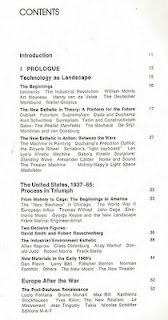"I'm inclined to think that if this sort of thing signifies anything, it
has more to do with the "cult of the curator" that emerged back in the
early 1990s and has stayed with us ever since. And perhaps the
curatorial class’s hailing or enshrining its own legacy
by commemorating a few grand moments from the past – those occasions
(infrequent as they were) when an ambitious, zeitgeist-defining
exhibition actually succeeded in corralling a corpus of work which would
not only define its moment, but point in the direction that art would
(in one way of another) be taking in the years that followed" --
Our God Is Speed addresses Holland Cotter's
contention of a "boom" in remountings of iconic exhibitions and the idea that this is part of
a larger malaise of retro art.
Our God adds:
"
Perhaps,
then, this might considered the manifestation of an underlying anxiety
among some curators -- about an inability to undertake any similarly
decisive endeavor in the present-day global art field?"
and suggests that "
Cotter's diagnosis" points not to a "
a pervasive condition" but is rather the braiding of "
several diffuse dynamics into a master narrative" of "
stasis,
nostalgia and ouroboric self-cannibalization"
(Which is kind of what "retromania" is - not a unified condition with a single underlying etiology, but the convergence of a number of discrete conditions into a synchronised peak of exacerbation).
In a
follow-up post,
Our God / Grayhoos discusses Claire Bishop's "Digital Divide" essay, focusing on the concept of obsolescence, and also suggests some other iconic exhibitions of the past that might merit remounting.
Along the way he mentions Nabokov's famous "
The future is but the obsolete in reverse" - an epigram that sometimes seems clear as day to me, but other times I'm like, "you what, guv?". And he points out that it comes from Vlad's 1952 short story “Lance,” which "t
akes the form of a science-fiction
tale concerning interplanetary travel" allowing Nabokov many opportunities to "
to vent his own loathing of
the science fiction genre".
Two other things that Nabokov loathed were Freud(ianism) and music! Disconcerting to me, because he is probably my favourite novelist, and three things that are absolutely central to my make-up are music, science fiction and psychoanalysis.
Still, who says you have to be in agreement with your favourite writers, artists, musicians etc?
He may have despised s.f. but he had a bash at the s.f. side-genre of alternative history / counterfactuals. Albeit more as the whimsical backdrop to the main story, which is an erotically fevered and doomed romance between two young (very young) lovers who discover they are half-siblings. I'm talking about
Ada, which takes place in a Russianized North America. How it came about I forget, something to do with the Tartars not stopping but conquering what would have Russia, driving the Russians out? As so often, my memory failing me (even though the book made
a
huge impression on me as a teenager) I turn to Wikipedia:
"
The story takes place in the late nineteenth century on what appears to be an alternative history
of Earth, which is there called Demonia or Antiterra. Antiterra has the
same geography and a largely similar history to that of Earth; however,
it is crucially different at various points. For example, the United
States includes all of the Americas (which were discovered by African
navigators). But it was also settled extensively by Russians, so that
what we know as western Canada is a Russian-speaking province called
"Estoty", and eastern Canada a French-speaking province called "Canady."
Russian, English, and French are all in use in North America. Russia
itself, and much of Asia, is part of an empire called Tartary,
while the word "Russia" is simply a "quaint synonym" for Estoty.
The
British Empire, which includes most or all of Europe and Africa, is
ruled (in the nineteenth century) by a King Victor. Aristocracy is still widespread, but some technology has advanced well into twentieth-century forms. Electricity, however, has been banned since almost the time of its discovery
following an event referred to as "the L-disaster". Airplanes and cars
exist, but televison and telephones do not, their functions served by similar devices powered by water. The
setting is thus a complex mixture of Russia and America in the
nineteenth and twentieth centuries.
The belief in a "twin" world, Terra, is widespread on Antiterra as a
sort of fringe religion or mass hallucination. (The name "Antiterra" may
be a back-formation from this; the planet is "really" called
"Demonia".) One of [protagonist] Van's early specialties as a psychologist is researching and working with people who believe that they are
somehow in contact with Terra. Terra's alleged history, so far as he
states it, appears to be that of our world: that is, the characters in
the novel dream, or hallucinate, about the real world."
The alt-history backdrop in
Ada, though, isn't really an exercise in speculative fiction so much as the excuse for Nabokov to lovingly, longingly recreate the lost world of his childhood as a member of the ruling class in pre-Bolshevik Russia. Similar to the consolatory function that Zembla serves for Kinbote in
Pale Fire.
Curious to reread
Ada as a grown-up (or a grown-er up, the last time was probably 25 years ago) as with critically sharper eyes I suspect I might find it a little over-ripe and mannered, and agree more with the generally mixed reception it got in its own time. But as a 15 year old it hit just the right spot where flushed-with-hormones meets speculative fiction/alternative history.




